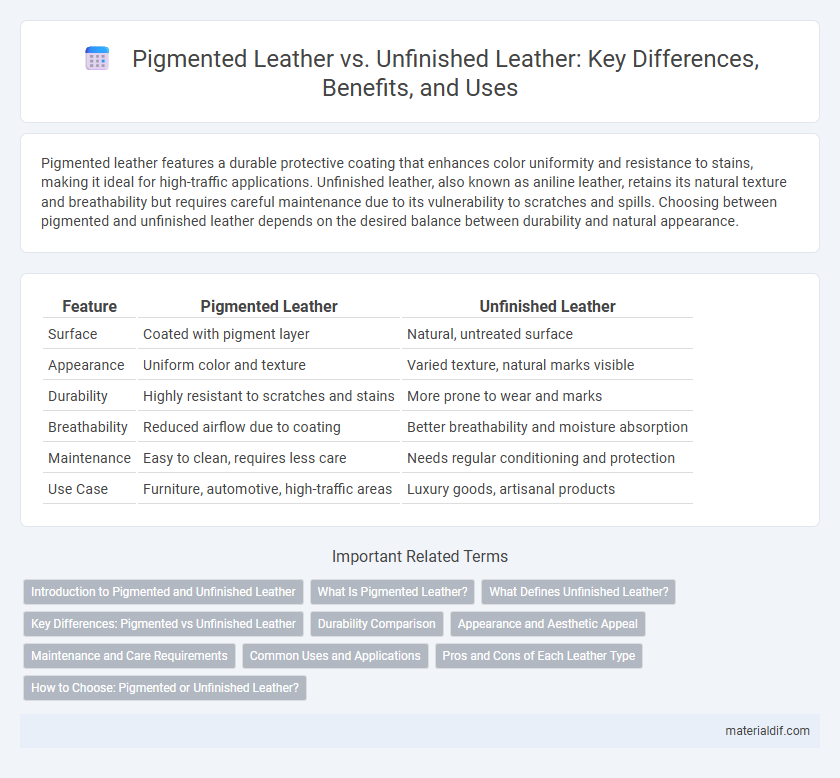Pigmented leather features a durable protective coating that enhances color uniformity and resistance to stains, making it ideal for high-traffic applications. Unfinished leather, also known as aniline leather, retains its natural texture and breathability but requires careful maintenance due to its vulnerability to scratches and spills. Choosing between pigmented and unfinished leather depends on the desired balance between durability and natural appearance.
Table of Comparison
| Feature | Pigmented Leather | Unfinished Leather |
|---|---|---|
| Surface | Coated with pigment layer | Natural, untreated surface |
| Appearance | Uniform color and texture | Varied texture, natural marks visible |
| Durability | Highly resistant to scratches and stains | More prone to wear and marks |
| Breathability | Reduced airflow due to coating | Better breathability and moisture absorption |
| Maintenance | Easy to clean, requires less care | Needs regular conditioning and protection |
| Use Case | Furniture, automotive, high-traffic areas | Luxury goods, artisanal products |
Introduction to Pigmented and Unfinished Leather
Pigmented leather features a protective topcoat with pigments that offer enhanced durability, color uniformity, and resistance to scratches and stains. Unfinished leather, also known as natural or aniline leather, retains its original surface without pigments or coatings, preserving its natural texture, breathability, and unique markings. Both types serve different aesthetic and functional purposes in upholstery, fashion, and automotive industries.
What Is Pigmented Leather?
Pigmented leather is leather treated with a protective surface layer that contains pigments, providing uniform color and enhanced durability. This finish improves resistance to stains, water, and wear while maintaining a consistent appearance across hides. It differs from unfinished leather, which lacks this coating and showcases a more natural, porous surface prone to variation and greater susceptibility to damage.
What Defines Unfinished Leather?
Unfinished leather is characterized by its natural surface that lacks any pigmented coatings or protective layers, allowing the hide's original texture, markings, and pores to remain visible. This type of leather retains its breathability and develops a unique patina over time, reflecting wear and usage. Unlike pigmented leather, unfinished leather offers a more organic appearance but requires more careful maintenance to preserve its quality.
Key Differences: Pigmented vs Unfinished Leather
Pigmented leather features a durable synthetic coating that enhances color consistency and provides superior protection against stains and wear, while unfinished leather retains its natural surface and absorbs oils and moisture, developing a unique patina over time. Pigmented leather offers increased resistance to fading and scratches due to its protective layer, whereas unfinished leather requires regular conditioning to maintain suppleness and prevent drying or cracking. The choice between pigmented and unfinished leather hinges on the desired balance between low maintenance durability and the authentic, evolving character of natural leather.
Durability Comparison
Pigmented leather features a protective surface coating that significantly enhances its resistance to scratches, stains, and fading, making it exceptionally durable for high-traffic use. Unfinished leather, such as aniline or natural leather, lacks this surface layer and develops a patina over time, which may result in increased vulnerability to wear and moisture damage. The durability of pigmented leather generally surpasses that of unfinished leather, especially in environments requiring robust surface protection and easy maintenance.
Appearance and Aesthetic Appeal
Pigmented leather boasts a uniform, glossy finish thanks to its protective topcoat, offering enhanced durability and resistance to stains and fading. Unfinished leather reveals the natural grain and texture, showcasing unique imperfections that contribute to a rustic and authentic aesthetic. The choice between pigmented and unfinished leather impacts the tactile experience and visual richness, with pigmented leather favoring consistency and unfinished leather emphasizing organic beauty.
Maintenance and Care Requirements
Pigmented leather features a durable topcoat that resists stains and fading, requiring minimal maintenance typically limited to regular dusting and occasional cleaning with a damp cloth. Unfinished leather, also known as natural or aniline leather, lacks a protective finish, demanding frequent conditioning with leather oils or creams to prevent drying, cracking, and discoloration. Proper care of unfinished leather involves avoiding prolonged exposure to sunlight and moisture to preserve its natural texture and appearance.
Common Uses and Applications
Pigmented leather features a durable surface coating ideal for automotive upholstery, furniture, and footwear due to its resistance to stains and fading. Unfinished leather, prized for its natural appearance and breathability, is commonly used in high-end fashion, handcrafted goods, and artisanal leather products. Both types cater to distinct market needs, with pigmented leather emphasizing durability and unfinished leather highlighting authenticity and texture.
Pros and Cons of Each Leather Type
Pigmented leather offers enhanced durability and resistance to stains and fading due to its protective surface coating, making it ideal for high-traffic applications, but it can feel less natural and may hide the leather's unique characteristics. Unfinished leather, also known as natural or aniline leather, provides a soft, breathable texture and showcases the authentic grain and markings of the hide, yet it is more susceptible to scratches, stains, and fading without a protective finish. Selecting between pigmented and unfinished leather depends on the desired balance between durability and natural aesthetics for specific use cases.
How to Choose: Pigmented or Unfinished Leather?
Pigmented leather features a protective coating that enhances durability and resistance to stains, making it ideal for high-traffic applications and products requiring easy maintenance. Unfinished leather, also known as aniline or natural leather, offers a soft, breathable surface with a rich, authentic patina that develops over time, favored for luxury goods and items prioritizing aesthetics over durability. Selecting between pigmented and unfinished leather depends on balancing the need for longevity and protection against the desire for natural texture and character.
Pigmented Leather vs Unfinished Leather Infographic

 materialdif.com
materialdif.com